 | |
| Company type | Privately held company |
|---|---|
| Founded | 1904 United States |
| Defunct | 1906 |
| Headquarters | United States |
The American Record Company was an American record label that was in business from 1904 to 1906.
 | |
| Company type | Privately held company |
|---|---|
| Founded | 1904 United States |
| Defunct | 1906 |
| Headquarters | United States |
The American Record Company was an American record label that was in business from 1904 to 1906.
The American Record Company (commonly abbreviated as "ARCo") was founded by Ellsworth A. Hawthorne and Horace Sheble, formerly designers of accessories for Edison Records machines at their Philadelphia-based bicycle shop; in a previous venture, they had issued a small run of brown-wax cylinders in the mid-1890s. [1] Hawthorne and Sheble partnered with John O. Prescott, whose brother Frederick worked with International Talking Machine in Berlin, which marketed Odeon Records. The new company was based in Springfield, Massachusetts, though they maintained factories in Bridgeport, CT and Philadelphia; recordings were made in a studio in New York City. [1] American principally produced single-sided, lateral-cut disc records on blue shellac, although two-sided issues and standard, black shellac appeared towards the end of the company's run. [2]
The label of the discs featured artwork depicting a Native American with a smoking pipe listening to a front-mount disc phonograph of undetermined manufacture; American Record Company advertising commonly marketed them as "Indian Records". [3] Several variations of the "Indian" label exist, differing only in minor details. [4] Most ARCo records are single sided; with their double-sided records, apparently the combination of sides were randomly chosen. The company would press any two sides paired, if the buyer met the minimum-order qualification. These records are notable for being blue in color, rather than the usual black, pressed from a shellac compound called Empedite which reputedly delivered better sound quality than standard black shellac. [5] The records appear to have been numbered using a sequence which began at 030000; the highest number known is 031435. [6] The records exist in 7-inch, 10-inch and 10.75-inch sizes, with the latter size being derived from its connection with Odeon, which also used that size. The seven-inch discs used a different numbering sequence and seem to have only been produced for a short time. Some export pressings for Britain carried the "American Odeon Record" logo.
Unlike most American producers of discs apart from Victor and Columbia in the first decade of the twentieth century, American Record Company made their own recordings in direct contravention to existing patents. The most important contribution made by ARCo to the history of recorded sound is that they made the earliest surviving records of Hawaiian music in several discs credited to the Royal Hawaiian Troubadours; this was a group led by July Paka. The house band was called the Regimental Band of the Republic and was responsible for most of the remaining instrumental selections on the label, in addition to providing accompaniments to singers. Other performers were mainly drawn from the ranks of singers that worked for Victor, Columbia and the cylinder companies, recording many of the same songs that they did elsewhere. Many ARCos are anonymous, though just as many if not more do carry an accurate credit as to the performer. [6] Collectors of early records do value ARCOs; while not as common as early Columbias or Victors, they survive in decent numbers, especially when compared to discs on labels that they provided masters to, such as Busy Bee, Kalamazoo and Peerless. In Europe, their releases appeared on Pelican, Leader, American Odeon and Odeon. [5]
A listing of some of the artists that appeared on American Record Company. [6]

In music, a single is a type of release, typically a song recording of fewer tracks than an LP record or an album. One can be released for sale to the public in a variety of formats. A single may be released as its own retail product, or it may be connected to an album.

A phonograph record, a vinyl record, or simply a record or vinyl is an analog sound storage medium in the form of a flat disc with an inscribed, modulated spiral groove. The groove usually starts near the outside edge and ends near the center of the disc. The stored sound information is made audible by playing the record on a phonograph.

The Victor Talking Machine Company was an American recording company and phonograph manufacturer, incorporated in 1901. Victor was an independent enterprise until 1929 when it was purchased by the Radio Corporation of America (RCA) and became the RCA Victor Division of the Radio Corporation of America until late 1968, when it was renamed RCA Records.

Berliner Gramophone – its discs identified with an etched-in "E. Berliner's Gramophone" as the logo – was the first disc record label in the world. Its records were played on Emile Berliner's invention, the Gramophone, which competed with the wax cylinder–playing phonographs that were more common in the 1890s and could record.

Leeds Talk-O-Phone was a record label, producing cylinders from 1894 to 1903 and single-sided lateral-cut disc phonograph records in the United States of America from about 1902 to 1909.

Columbia Graphophone Co. Ltd. was one of the earliest gramophone companies in the United Kingdom.

Pathé Records was an international record company and label and producer of phonographs, based in France, and active from the 1890s through the 1930s.
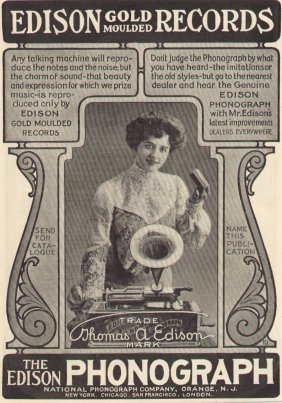
Edison Records was one of the early record labels that pioneered sound recording and reproduction, and was an important and successful company in the early recording industry.
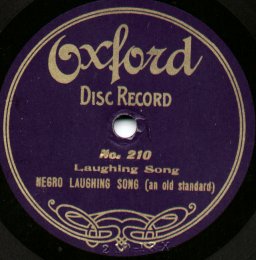
Oxford Records was a record label active in the United States of America from roughly 1906 until 1916. The label was produced for Sears by several labels, including Columbia and Albany Indestructible Cylinders for cylinders and Leeds & Catlin, Zon-O-Phone, and Columbia for discs. No recording activity was undertaken by Sears. All discs were single-sided.
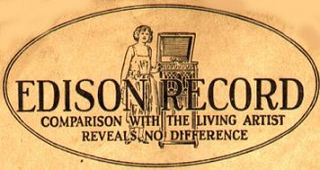
The Edison Diamond Disc Record is a type of phonograph record marketed by Thomas A. Edison, Inc. on their Edison Record label from 1912 to 1929. They were named Diamond Discs because the matching Edison Disc Phonograph was fitted with a permanent conical diamond stylus for playing them. Diamond Discs were incompatible with lateral-groove disc record players, e.g. the Victor Victrola, the disposable steel needles of which would damage them while extracting hardly any sound. Uniquely, they are just under 1⁄4 in thick.

Frederick William Gaisberg was an American musician, recording engineer and one of the earliest classical music producers for the gramophone. He himself did not use the term 'producer', and was not an impresario like his protégé Walter Legge of EMI or an innovator like John Culshaw of Decca. Gaisberg concentrated on talent-scouting and persuading performers to make recordings for the newly invented Gramophone.

The overwhelming majority of records manufactured have been of certain sizes, playback speeds, and appearance. However, since the commercial adoption of the gramophone record, a wide variety of records have also been produced that do not fall into these categories, and they have served a variety of purposes.

Odeon Records is a record label founded in 1903 by Max Straus and Heinrich Zuntz of the International Talking Machine Company in Berlin, Germany. The label's name and logo come from the Odéon-Théâtre de l'Europe in Paris.

Byron George Harlan was an American singer from Kansas, a comic minstrel singer and balladeer who often recorded with Arthur Collins. The two together were often billed as "Collins & Harlan".
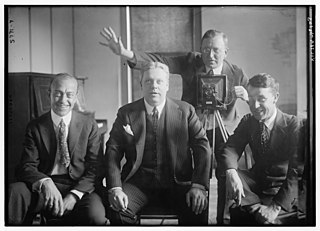
The Peerless Quartet was an American vocal group that recorded in the early years of the twentieth century. They formed to record for Columbia Records, where they were credited as the Columbia Quartet or Columbia Male Quartet. From about 1907, when they began to record for record labels other than Columbia, they were more widely known as the Peerless Quartet.

The LP is an analog sound storage medium, a phonograph record format characterized by: a speed of 33+1⁄3 rpm; a 12- or 10-inch diameter; use of the "microgroove" groove specification; and a vinyl composition disk. Introduced by Columbia Records in 1948, it was soon adopted as a new standard by the entire US record industry. Apart from a few relatively minor refinements and the important later addition of stereophonic sound in 1957, it remained the standard format for record albums, during a period in popular music known as the album era. Beginning in the late 1970s, LP sales began to decline due to the increasing popularity of cassette tapes and compact discs (CDs). By 1988, the latter format began to outsell LPs.
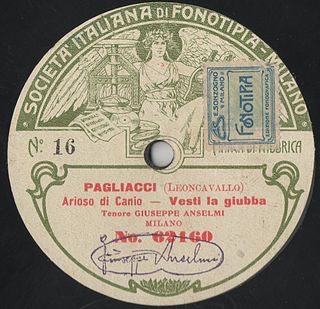
Fonotipia Records, or Dischi Fonotipia, was an Italian gramophone record label established in 1904 with a charter to record the art of leading opera singers and some other celebrity musicians, chiefly violinists. Fonotipia continued to operate into the electrical recording era, which commenced in 1925–26, by which time the company had been absorbed into Odeon records. The records made by Fonotipia are prized by collectors and musicologists for their high technical quality, and for the high artistic merit and interest of much of what was captured for posterity.

Charles William Harrison was an American tenor ballad singer. He recorded under the pseudonyms: Hugh Donovan, Billy Burton, Charles Hilton, and Norman Terrell.

Aretino was a United States record label, in business from about 1907 to 1914.
Busy-Bee was a Chicago-based record label founded in 1904 that sold both cylinders and discs, often with content licensed from other labels. Their cylinders could only be played on special Busy-Bee players. A 1906 cylinder catalog shows artists including Gilmore's Band, Billy Murray, Arthur Collins, Bob Roberts, and Ada Jones.